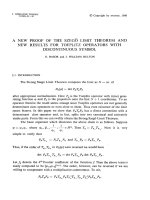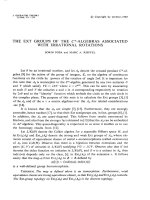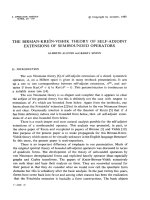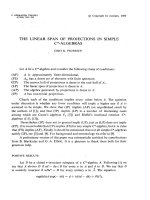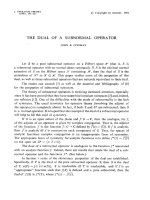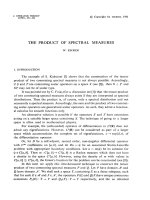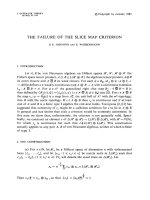Báo cáo toán học: "The lower tail of the random minimum spanning tree" ppsx
Bạn đang xem bản rút gọn của tài liệu. Xem và tải ngay bản đầy đủ của tài liệu tại đây (85.06 KB, 4 trang )
The lower tail of the random minimum spanning tree
Abraham D. Flaxman
Microsoft Research
Redmond, WA, USA
Submitted: Sep 11, 2006; Accepted: Dec 15, 2006; Published: Jan 17, 2007
Mathematics Subject Classifications: 05C80, 60C05
Abstract
Consider a complete graph K
n
where the edges have costs given by independent
random variables, each distributed uniformly between 0 and 1. The cost of the min-
imum spanning tree in this graph is a random variable which has been the sub-
ject of much study. This note considers the large deviation probability of this ran-
dom variable. Previous work has shown that the log-probability of deviation by ε
is −Ω(n), and that for the log-probability of Z exceeding ζ(3) this bound is correct;
log Pr[Z ≥ ζ(3) + ε] = −Θ(n). The purpose of this note is to provide a simple proof
that the scaling of the lower tail is also linear, log Pr[Z ≤ ζ(3) − ε] = −Θ(n).
1 Introduction
If the edge costs of the complete graph K
n
are independent random variables, each uni-
formly distributed between 0 and 1, then the cost of a minimum spanning tree is a random
variable which has expectation asymptotically equal to ζ(3) =
∞
i=1
i
−3
[6]. Furthermore,
after an appropriate rescaling, this random variable converges in distribution to a Gaussian
distribution with an explicitly known variance of about 1.6857 [8]. This note considers the
large deviation probability of this random variable, denoted Z
n
.
In [9], as an example application of Talagrand’s Inequality, McDiarmid shows that Z
n
satisfies an exponential tail inequality of the form
Pr[|Z
n
− ζ(3)| ≥ ε] ≤ e
−C
ε
n
.
(See also [4] for an alternative approach with additional details). Simple considerations
show that for the log-probability of Z
n
exceeding ζ(3) this bound is correct, which is to
say that log Pr[Z
n
≥ ζ(3) + ε] = −Θ(n). For example, the probability that every edge
incident to vertex 1 has cost at least 1/2 is (1/2)
n−1
, and conditioned on this event, whp
Z
n
= (1 + o(1))(ζ(3) + 1/2).
the electronic journal of combinatorics 14 (2007), #N3 1
The behavior of the lower tail is not as simple to identify. A casual inspection may lead
to the conjecture that the lower tail is even more tightly concentrated than the upper tail.
The previous paragraph described how an overly large value of Z
n
can be “blamed” on a
single vertex which has only expensive edges. However, for a single vertex to be similarly
responsible for the cost of the tree being significantly lower than expected, it needs to have
a lot of edges with cost less than ζ(3)/n. This occurs with log-probability of −Θ(n log n).
The purpose of this note is to show that the lower tail of Z
n
is at least e
−Cn
for any
constant deviation less than ζ(3). (Note that, for example, Pr[Z
n
≤ ζ(3) − (ζ(3) − n
−10
)], is
not at least e
−Cn
.)
Theorem 1 Let the random variable Z
n
be the cost of the minimum spanning tree when the
edges of the complete graph K
n
have costs selected independently and uniformly at random
in the interval [0, 1]. Then, for any constant ε < 1, there exists a constant C
ε
> 0, such that
for all sufficiently large n,
Pr[Z
n
≤ (1 − ε)ζ(3)] ≥ e
−C
ε
n
.
This scaling behavior rules out the possibility that the lower tail of Z
n
is asymptotically
more tightly concentrated than the currently best-known upper bound. This is in contrast
with, for example, the result on the concentration of the eigenvalues of a random matrix due
to Alon, Krivelevich, and Vu [2]. That paper considers how tightly an eigenvalue of a random
matrix is concentrated around its mean, and shows that, for example, the log-probability of
deviation of the first eigenvalue of the adjacency matrix of G
n,1/2
of scales like −Ω(n
2
).
2 Lower bound
The argument establishing a lower bound is based on the observation that if the weights
on the edges are independent and given by the minimum of 2 random variables selected
uniformly at random from [0, 1] then the expected cost is ζ(3)/2 (this is proved by Steele
in [10] and extended by Frieze and McDiarmid in [7]; in fact, the only feature of the edge
weight distribution that is important to the expected value of Z
n
is the behavior of the
density function at 0.)
To make use of this observation, consider the following complicated way to generate Z
n
:
Look first at a larger probability space, where each edge has 2 values, X
+
e
and X
−
e
, and each
vertex has a polarity chosen uniformly at random, Φ(v) ∈ ±1. Then, to obtain Z
n
, consider
the graph where edge e = {u, v} has weight Y
e
= X
Φ(u)Φ(v)
e
.
Edge weights generated in this manner are identically distributed with the original model,
and so the cost of the minimium spanning tree is distributed identically with Z
n
. But with
this generative procedure it is easy to obtain a lower bound on the log-probability of the
event {Z
n
≤ 3(ζ(3) + δ)/4} (when δ is arbitrarily small and n is sufficiently large). Consider
the minimum spanning tree in the graph where edge e has weight min{X
+
e
, X
−
e
}. Since this
is a tree, there is a function ψ which assigns every vertex a polarity so that X
ψ(u)ψ(v)
e
is the
minimum of the 2 values. (To see this, designate some vertex to be the root, and start by
the electronic journal of combinatorics 14 (2007), #N3 2
arbitrarially assigning a polarity to the root, and then assigning the polarity of additional
vertices in the order given by a breadth-first search of the minimum spanning tree.) If this
function is the one that comes up, then the expected cost of Z
n
is asymptotic to ζ(3)/2, and,
for sufficiently large n, by Markov’s inequality, Pr[Z
n
≥ 3/2(ζ(3) + δ)/2 | Φ = ψ] ≤ 2/3.
The event {Φ = ψ} has the same probability as the event that Φ equals any other polarity
function, so unconditionally, for sufficiently large n, Pr[Z
n
≤ 3(ζ(3) + δ)/4] ≥ (1/3)2
−n
.
For values of ε ≥ 1/4, repeat this argument but with the larger probability space con-
taining k different weights for each edge, and vertex polarity chosen uniformly from the k
complex roots of unity, Φ(v) ∈
e
2πi·
0
k
, e
2πi·
1
k
, . . . , e
2πi·
k−1
k
. Again, considering as a weight
the minimum of the k weights on each edge leads to the expected value asymptotic to ζ(3)/k,
and, for sufficiently large n, the probability that this random variable exceeds 2(ζ(3) + δ)/k
is at most 1/2. Since there is again a function ψ that results in selecting the minimum
value for each edge in the minimum spanning tree, an upper-bound on the unconditional
probability is
Pr[Z
n
≤ 2(ζ(3) + δ)/k] ≥ (1/2)k
−n
.
Note that this argument also works when k is a function of n, showing that
log Pr[Z
n
= O(1/k)] = −Ω(n log k).
3 Conclusion
This note provides a simple proof that, for sufficiently large n, the probability of the cost of
a minimum spanning tree being less than (1 − ε)ζ(3) is at least e
−C
ε
n
. The proof technique
described in Section 2 can also be applied to prove lower bounds on the probabilities of
other functions being less than their means. It is only necessary to know that (1) when
each variable is replaced by the minimum of k copies, the expected value of the function
decreases by a factor of k; and that (2) it is possible to describe which one of the k copies is
used by the function with O(n) bits. For the minimum perfect matching problem, it follows
from the work of Aldous [1] that condition (1) is met, and condition (2) can be satisfied as
above. For the minimum traveling salesperson problem, W¨astlund’s results in [11] show that
condition (1) is met, and condition (2) can satisfied by setting polarities for n − 1 vertices
and specifying n − 1 additional values for the edges incident to the vertex. For the minimum
set of edges which can be partitioned into 2 disjoint spanning trees, condition (1) is implicit
in the work of Avram and Bertsimas [3] (see [5] for additional detail), but it is not clear how
to demonstrate condition (2) in a simple manner.
References
[1] Aldous, D. J. Asymptotics in the random assignment problem. Probab. Theory
Related Fields 93, 4 (1992), 507–534.
the electronic journal of combinatorics 14 (2007), #N3 3
[2] Alon, N., Krivelevich, M., and Vu, V. H. On the concentration of eigenvalues
of random symmetric matrices. Israel J. Math. 131 (2002), 259–267.
[3] Avram, F., and Bertsimas, D. The minimum spanning tree constant in geometrical
probability and under the independent model: a unified approach. Ann. Appl. Probab.
2, 1 (1992), 113–130.
[4] Flaxman, A. D., Frieze, A., and Krivelevich, M. On the random 2-stage
minimum spanning tree. Random Structures Algorithms 28, 1 (2006), 24–36.
[5] Flaxman, A. D., Vera, J., and Frieze, A. M. On edge-disjoint spanning trees in
a randomly weighted complete graph. Manuscript in preparation, 2006.
[6] Frieze, A. M. On the value of a random minimum spanning tree problem. Discrete
Appl. Math. 10, 1 (1985), 47–56.
[7] Frieze, A. M., and McDiarmid, C. J. H. On random minimum length spanning
trees. Combinatorica 9, 4 (1989), 363–374.
[8] Janson, S. The minimal spanning tree in a complete graph and a functional limit
theorem for trees in a random graph. Random Structures Algorithms 7, 4 (1995), 337–
355.
[9] McDiarmid, C. On the method of bounded differences. In London Mathematical
Society Lecture Note Series, vol. 141. Cambridge University Press, 1989, pp. 148–188.
[10] Steele, J. M. On Frieze’s ζ(3) limit for lengths of minimal spanning trees. Discrete
Appl. Math. 18, 1 (1987), 99–103.
[11] W
¨
astlund, J. The travelling salesman problem in the stochastic mean field model.
Unpublished manuscript, 2006.
the electronic journal of combinatorics 14 (2007), #N3 4
